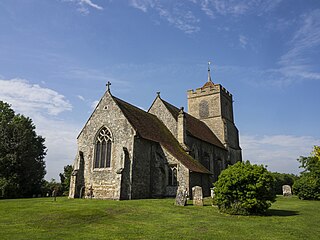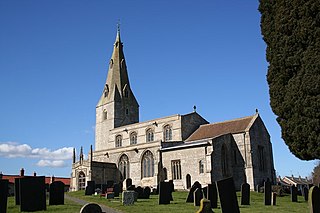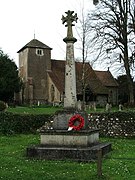
Battlesden is a hamlet and civil parish in the Central Bedfordshire district of Bedfordshire, England. It is just north of the A5, between Dunstable and Milton Keynes. According to the 2001 census, it had a population of 38. Because of its low electorate, it has a parish meeting rather than a parish council. It is in the civil parish of Milton Bryan.

All Saints Church is the Anglican parish church of Patcham, an ancient Sussex village which is now part of the English city of Brighton and Hove. A place of worship has existed on the hilltop site for about 1,000 years, but the present building has Norman internal features and a 13th-century exterior. Several rounds of restoration in the Victorian era included some structural additions. A wide range of monuments and wall paintings survive inside, including one commemorating Richard Shelley—owner of nearby Patcham Place and one of the most important noblemen in the early history of Brighton. The church, which is Grade II* listed, continues to serve as the Anglican place of worship for residents of Patcham, which 20th-century residential development has transformed from a vast rural parish into a large outer suburb of Brighton.

St Margaret's Church is an Anglican church in the Ifield neighbourhood of Crawley, a town and borough in West Sussex, England. It is the ancient parish church of the village of Ifield; the medieval settlement was expanded to form one of the New Town of Crawley's 13 neighbourhoods, and the church's modern parish now serves several other neighbourhoods as well.

St Peter's Church is the Church of England parish church of the parish of Ardingly in Mid Sussex, one of seven local government districts in the English county of West Sussex. The present building dates from the 14th century and was restored during the Victorian era, but Christian worship on the site has a much longer history. The stone-built, Decorated Gothic-style church, west of the village centre, has been designated a Grade I Listed building.

St Mary's Church is an Anglican church in the village of Walberton in the district of Arun, one of seven local government districts in the English county of West Sussex. Its 11th-century origins are now mostly hidden behind the results of extensive restoration work undertaken since the 18th century; but some Saxon-era fragments remain, and reused Roman building materials can still be seen in the walls. The extensive collection of 18th-century gravestones in the churchyard includes some especially macabre examples. The church is protected as a Grade I Listed building.

St Mary's Church is an Anglican church in the village of Slaugham in Mid Sussex, one of seven local government districts in the English county of West Sussex. The 12th- and 13th-century church, restored in the Victorian era, serves a large rural area of the Sussex Weald, covering three villages as well as the ancient settlement of Slaugham. It also controlled the church in the market town of Crawley—now one of the area's largest towns—for the first few centuries of its existence. A locally important family built a private chapel in the church in the 17th century, and a series of memorials to deceased family members are considered to be excellent examples of their type. English Heritage has listed the building at Grade II* for its architectural and historical importance.

Leighton Bromswold is a small village and civil parish in Cambridgeshire, England. Leighton lies approximately 10 miles (16 km) west of Huntingdon. Leighton is situated within Huntingdonshire which is a non-metropolitan district of Cambridgeshire as well as being a historic county of England. The civil parish of which it is part is called Leighton and in 2001 had a population of 224, falling to 210 at the 2011 Census. The parish covers an area of 3,128 acres (1,266 ha).

St Andrew's Church is a redundant Anglican church in the village of Buckland, Hertfordshire, England. It is recorded in the National Heritage List for England as a designated Grade II* listed building, and is under the care of the Churches Conservation Trust. The church stands at the highest point in the village to the east of Ermine Street, now the A10 road, between Royston and Buntingford.

St Mary Magdalene's Church is the former Anglican parish church of the hamlet of Tortington in the district of Arun, one of seven local government districts in the English county of West Sussex. Founded in the 12th century to serve a priory and villagers in the riverside location, it has experienced little change despite a 19th-century restoration. Its ancient chancel arch and doorway have remarkable carvings with "grotesque, boggle-eyed monsters", rare beakhead figures and chevron ornamentation. Standing in a picturesque setting behind a farm, the flint and Caen stone building was used for worship until 1978, when it was declared redundant. It is now cared for by the Churches Conservation Trust, and English Heritage has listed it at Grade II for its architectural and historical importance. The church is dedicated to Jesus's companion Mary Magdalene.

St Margaret's Church is an Anglican church in the village of West Hoathly in Mid Sussex, one of seven local government districts in the English county of West Sussex.

St George's Church is an Anglican church in the village of Eastergate in West Sussex, England. It is the ancient parish church of Eastergate, although since 1992 it has been administered as part of a joint ecclesiastical parish with the churches in neighbouring Barnham and Aldingbourne. As part of this group, the building is still in regular use for worship on Sundays and weekdays. Eastergate village school has links with the church, and pupils regularly attend services.

St Michael's Church is in the village of Burgh by Sands, Cumbria, England. It is an active Anglican parish church in the deanery of Carlisle, the archdeaconry of Carlisle, and the diocese of Carlisle. Its benefice is united with those of St Andrew, Aikton, St Mary, Kirkandrews-on-Eden with Beaumont, and St Peter, Kirkbampton. The church is recorded in the National Heritage List for England as a designated Grade I listed building. It is a fortified church standing on the line of Hadrian's Wall, and is unique in having had two fortified towers.

St Andrew's Church is in the village of Crosby Garrett, Cumbria, England. It is an active Anglican parish church in the deanery of Appleby, the archdeaconry of Carlisle, and the diocese of Carlisle. Its benefice is united with those of Kirkby Stephen Parish Church and St Mary, Mallerstang. The church is recorded in the National Heritage List for England as a designated Grade I listed building.

All Saints' Church is a 13th-century pilgrims' Grade I listed church in Boughton Aluph near Ashford, Kent. It is part of the Church of England.

All Saints Church is a parish church in Hollingbourne, Kent. It was begun in the 14th century and is a Grade I listed building. The church contains numerous monuments to the local Culpeper family.

St Peter's and St Paul's Church is a parish church in Yalding, Kent, dedicated to saints Peter and Paul. It was begun in the 13th century and is a Grade I listed building.

St Martin's Church is a Grade I listed Anglican church, dedicated to Martin of Tours, in Ancaster, Lincolnshire, England. The church is 6 miles (10 km) north-east from Grantham, below the southern edge of the Lincoln Cliff, and at the side of High Dyke, part of the old Ermine Street Roman road. St Martin's is in the ecclesiastical parish of Ancaster and Wilsford, in the Deanery of Loveden, and the Diocese of Lincoln.

St Peter's Church is a Grade I listed Anglican parish church dedicated to Saint Peter, in Ropsley, Lincolnshire, England. The church is 5 miles (8 km) east from Grantham, and in the South Kesteven Lincolnshire Vales. St Peter's is in the ecclesiastical parish of Ropsley, and is part of the North Beltisloe Group of churches in the Deanery of Beltisloe, and the Diocese of Lincoln.

St Nicholas' Church is a Grade I listed parish church in the village of Berden, Essex, England.

St James the Great Church is a Grade I listed Church of England parish church dedicated to James, son of Zebedee in Aslackby, Lincolnshire, England. The church is 7 miles (11 km) north from Bourne, and in the Aslackby and Laughton parish on the eastern edge the South Kesteven Lincolnshire Vales.




























